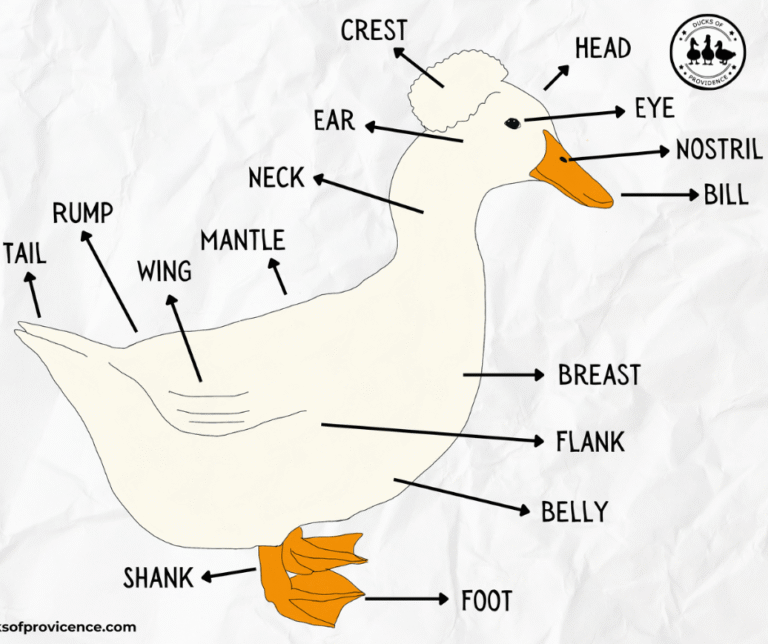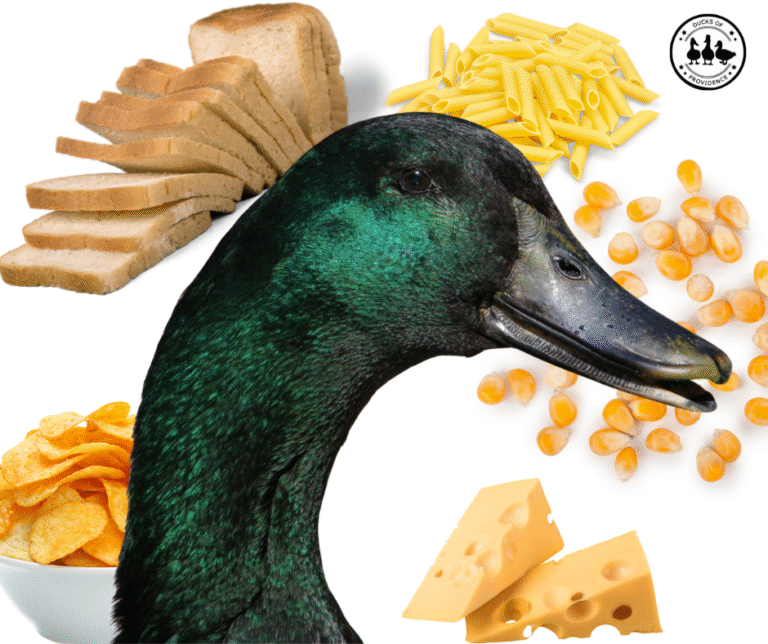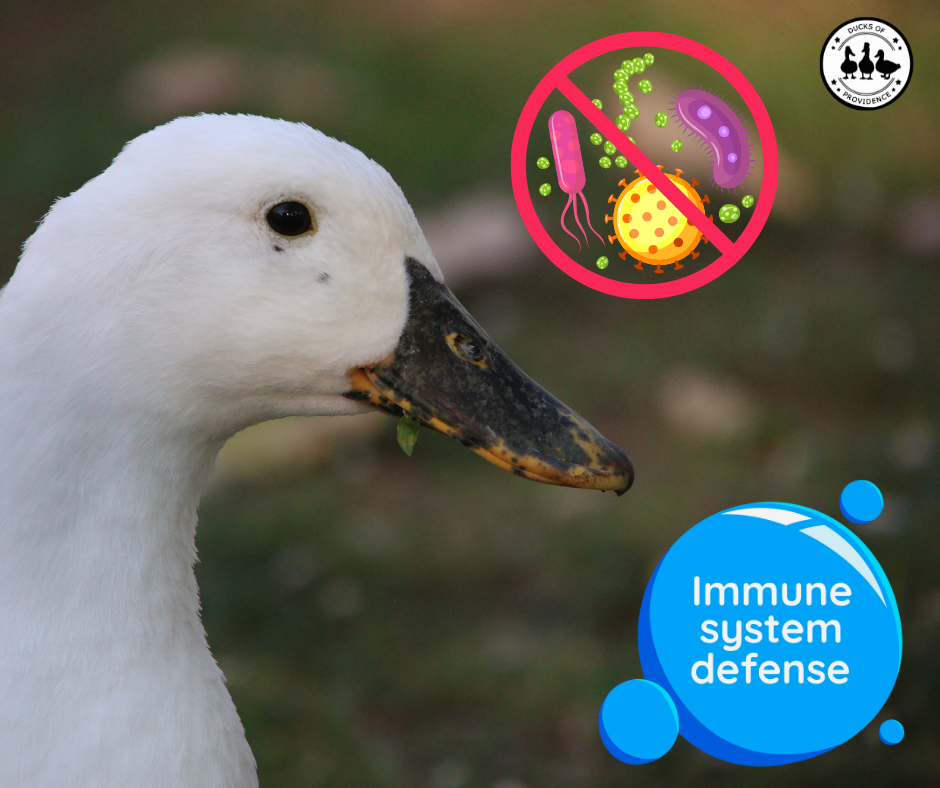
How the Duck Immune System Works and Ways to Support It Naturally
Ducks may look carefree as they splash in puddles and preen their feathers, but their ability to stay healthy depends on a remarkable internal defense system. The duck immune system works around the clock to protect them from bacteria, viruses, and parasites, helping them stay strong in all kinds of environments.
Understanding how this system functions is essential for every duck keeper. From the physical barriers that block pathogens to the specialized cells that recognize and destroy invaders, a duck’s immune system is both efficient and fascinating. Ducks also possess unique immune traits that make them more resistant to certain diseases than chickens.
In this post, we will explore how the duck immune system works, what factors can weaken or strengthen it, and how you can support your ducks’ natural defenses through good nutrition, clean housing, and proper care. Whether you are new to keeping ducks or have years of experience, these insights will help you keep your ducks healthy, happy, and resilient throughout the year.
Ducks of Providence is free, thanks to reader support! Ads and affiliate links help us cover costs—if you shop through our links, we may earn a small commission at no extra cost to you. Thanks for helping keep our content free and our ducks happy! 🦆 Learn more
How the Duck Immune System Works
The duck immune system is a finely tuned network of cells, tissues, and organs that protects the body from harmful bacteria, viruses, parasites, and fungi. It is one of the main reasons ducks are such hardy and adaptable birds. Whether swimming through chilly water or foraging in muddy puddles, their immune defenses work constantly to keep them healthy and strong.
Like in humans, the duck immune system has two main parts: the innate immune system and the adaptive immune system. You can think of the innate system as the body’s first responder and the adaptive system as the memory keeper that learns from past encounters.
Innate Immune System
The innate immune system provides fast, broad protection. It does not need to recognize a specific germ. It simply acts immediately when something seems wrong.
For ducks, this starts right on the surface. The skin and waterproof preen oil form a strong external barrier that keeps pathogens from entering the body. When ducks preen, they spread this oil across their feathers, not only to stay dry but also to coat themselves in a layer that naturally repels some bacteria and fungi.
The mucous membranes that line the eyes, mouth, and airways are also part of this defense. They trap dust, debris, and microbes before they can travel deeper into the body. Enzymes in the mucus break down bacteria, while specialized immune cells called macrophages and heterophils patrol the bloodstream, seeking out invaders and digesting them through a process known as phagocytosis.
Even behaviors like preening and bathing support immunity. Regular access to clean water allows ducks to wash away parasites, stimulate oil production, and maintain the health of their skin and feathers, all of which directly benefit the immune system.
The Science Behind Duck Immunity
Beyond these surface-level defenses lies a remarkable genetic system that gives ducks an edge over many other birds. Scientists have discovered that ducks possess a special gene called retinoic acid inducible gene I (RIG I), which plays a major role in antiviral defense.
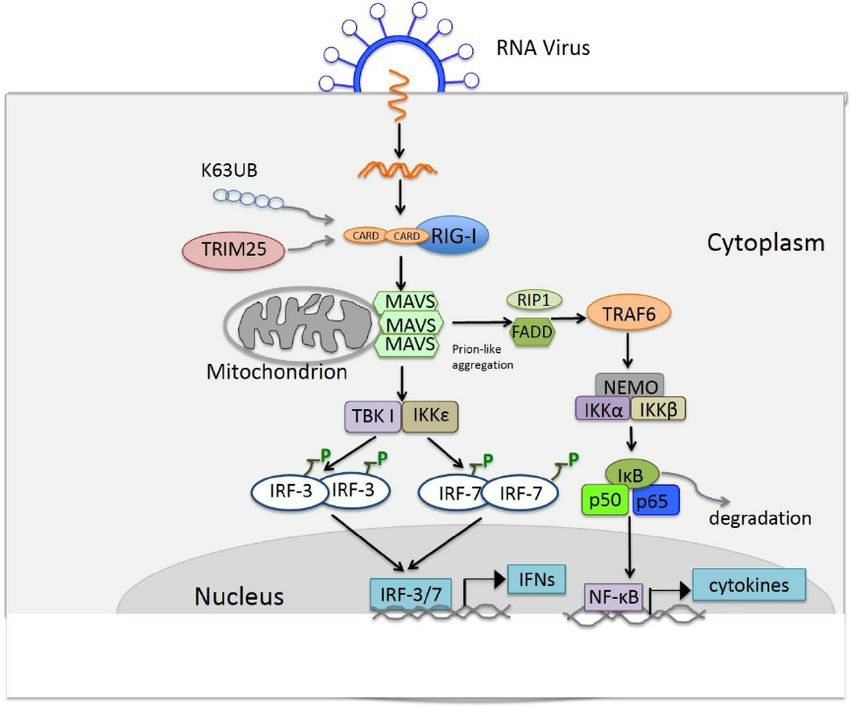
Here’s how it works: when a virus enters a duck’s body, RIG I detects fragments of viral RNA inside infected cells. Once it recognizes the intruder, RIG I triggers a chain reaction that activates interferon beta (IFN β), a powerful signaling protein. IFN β alerts surrounding cells to strengthen their defenses and activates hundreds of antiviral genes across the body.
This rapid, system-wide response makes it much harder for the virus to spread. Chickens, interestingly, lack the RIG I gene altogether, which is one reason they are more susceptible to diseases such as avian influenza. Ducks, on the other hand, can often fight off infection before symptoms become severe.
Studies show that RIG I and IFN β levels increase within hours after exposure to avian influenza viruses (AIVs). Even though highly pathogenic strains like H5N8 can temporarily suppress this response in the lungs, ducks typically recover within a few days once the immune system rebounds.
This ability to detect and fight viruses so efficiently is a defining feature of the duck’s innate immune system, a perfect example of nature’s built-in resilience.
Adaptive Immune System
If a pathogen manages to bypass the innate defenses, the adaptive immune system takes charge. This part of the immune system learns from each encounter, building memory so it can respond faster the next time. It is slower to act at first but much more targeted and powerful once activated.
The adaptive immune system in ducks relies on immunoglobulins (antibodies), lymphocytes, and cell-mediated immune responses. Ducks produce three main types of antibodies:
- IgM – the first antibody produced when an infection begins.
- IgY – the avian equivalent of mammalian IgG, responsible for long-term protection and immune memory.
- IgA – crucial for mucosal immunity in the respiratory, digestive, and reproductive tracts.
IgA develops later in young ducks, usually between two and seven weeks of age, which helps explain why ducklings are more vulnerable to infection early in life. During this period, they rely on the antibodies passed from their mother through the egg yolk for protection.
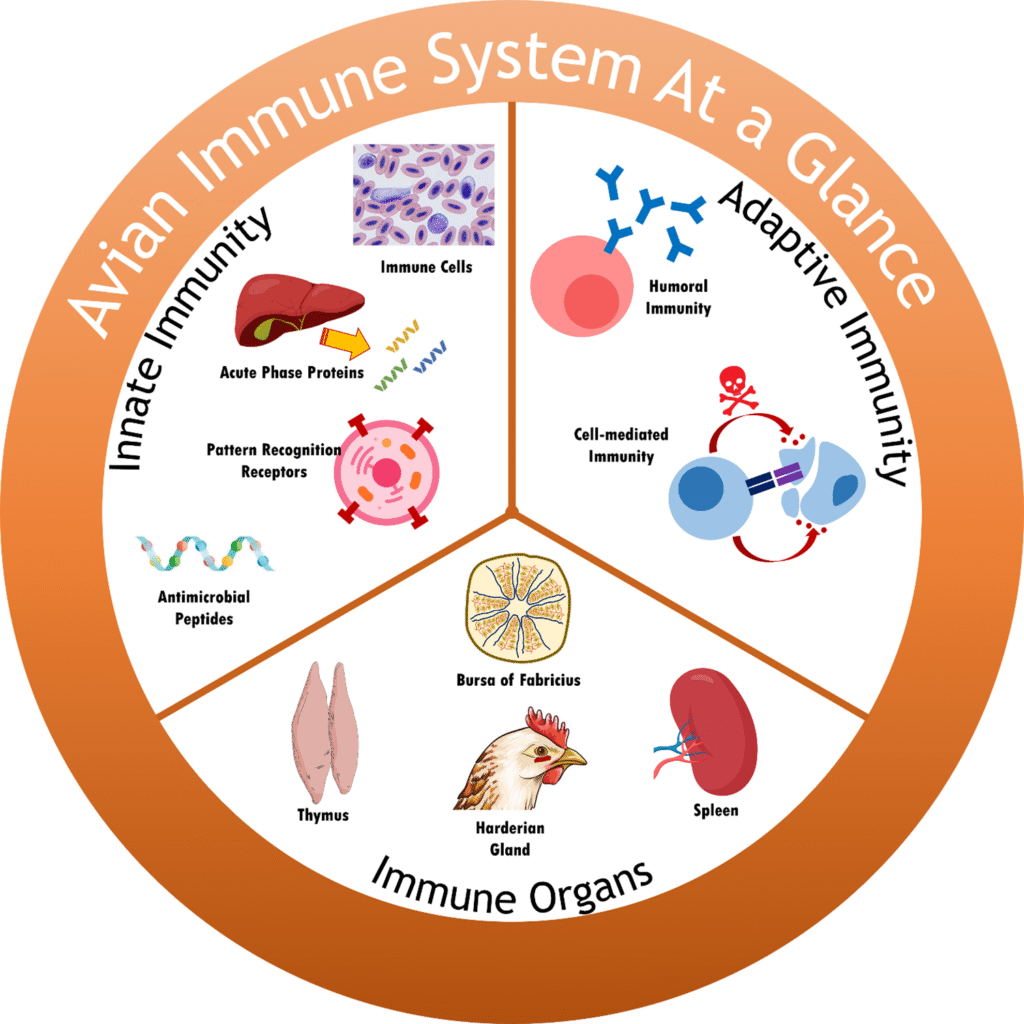
When a duck encounters a pathogen, B cells produce antibodies that recognize and neutralize that specific invader, while T cells help coordinate the attack and destroy infected cells. Once the infection is cleared, memory cells remain in the body, allowing for a faster and stronger response if the duck is ever exposed to the same germ again.
This adaptive system, paired with the duck’s powerful innate response, gives ducks both immediate protection and long-term immunity. Together, they form one of the most effective immune systems among domestic birds, strong enough to handle life outdoors while still delicate enough to need proper care and support.
Key Organs and Components of the Duck Immune System
A duck’s immune system is not limited to the white blood cells that circulate in its bloodstream. It also depends on a network of specialized organs and tissues that work together to recognize, filter, and destroy harmful invaders. Each part has a unique job, and together they form a powerful system that keeps ducks healthy and resilient. Understanding these structures helps duck keepers appreciate both the strength and the sensitivity of the duck immune system.
Bursa of Fabricius
The bursa of Fabricius is one of the most essential immune organs in young ducks. Located just above the cloaca near the tail, this small sac-like structure is the training ground for B cells, the immune cells that produce antibodies. In this organ, immature B cells learn to recognize which substances belong to the duck’s own body and which ones are foreign.
The bursa is only active for a limited time. During the first few months of a duck’s life, it is large and active, helping build a strong foundation for antibody production. As the duck matures, the bursa shrinks and eventually becomes inactive, but the B cells it produced continue to provide long-lasting immunity. Without the bursa, a duck would not be able to develop a proper antibody response to fight off infections.
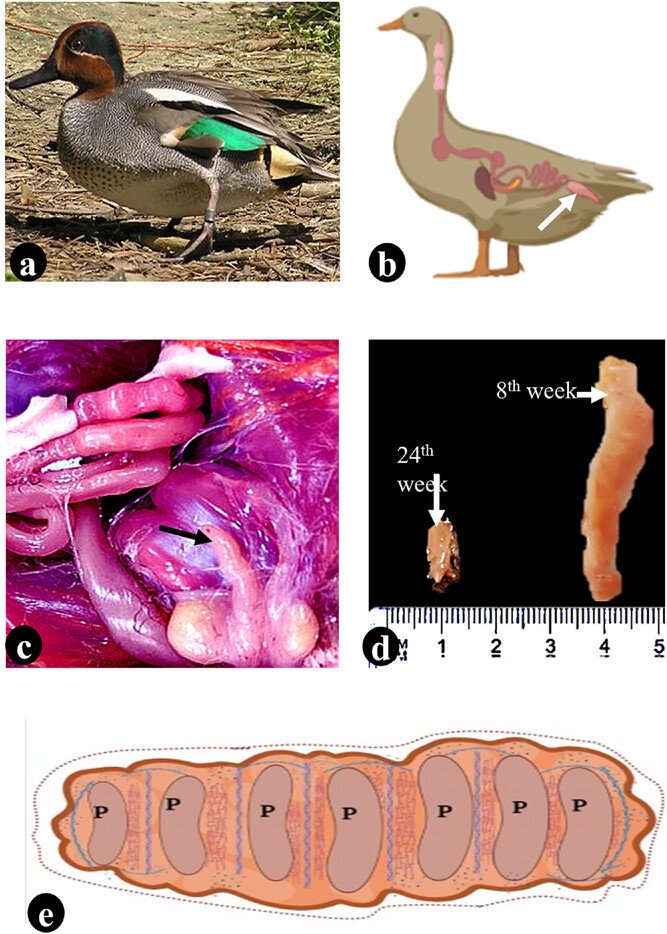
Thymus
The thymus is another critical immune organ, located on both sides of the neck along the trachea. It plays a central role in shaping the adaptive immune system by developing T cells, which help coordinate immune responses and destroy infected or abnormal cells. The thymus teaches these cells how to recognize harmful agents without attacking the body’s own tissues.
Like the bursa, the thymus is most active in young ducks. It becomes smaller with age, but its influence remains. Ducks that had a healthy thymus early in life retain the benefits of a well-trained immune system throughout adulthood.
Spleen
The spleen acts as the central hub of immune activity in ducks. It filters the blood, removes old or damaged red blood cells, and captures pathogens that may be circulating in the bloodstream. Inside the spleen, immune cells communicate with one another, mounting coordinated defenses when foreign material is detected.
A healthy spleen supports a strong immune response, helping ducks recover more efficiently from infections. Because of its role as a filtration system, an enlarged or pale spleen is often a sign of disease, which veterinarians sometimes check during diagnostic exams or necropsies.
Liver
The liver is not only a digestive organ but also a vital component of the immune system. It produces many of the body’s immune-related proteins, including complement proteins that assist antibodies in destroying pathogens. These complement proteins work like molecular alarms, marking invaders for attack and helping other immune cells locate them.
The liver also plays an important role in detoxifying the body. It processes and neutralizes toxins that enter through food, water, or environmental exposure. In doing so, it prevents harmful substances from accumulating in the bloodstream and overwhelming the immune defenses. A healthy liver is therefore essential for both immune balance and overall vitality.
Bone Marrow
Deep inside the bones lies the bone marrow, where all new blood cells are created. This includes white blood cells, the key soldiers of the immune system. The bone marrow continuously produces these cells and releases them into circulation, ensuring the duck is always ready to respond to infection or injury.
The marrow also produces platelets for clotting and red blood cells for oxygen transport, showing how closely the immune and circulatory systems are connected. If the bone marrow becomes damaged or suppressed, the entire immune system weakens.
Gut Associated Lymphoid Tissue (GALT)
Ducks are constantly exposed to microbes through their feeding habits. They dabble, sift, and filter water and mud for food, which means their digestive systems meet countless bacteria each day. The gut associated lymphoid tissue, often referred to as GALT, acts as a front-line guard inside the intestines.
This tissue contains clusters of immune cells that identify harmful bacteria or parasites and trigger local immune responses before the infection spreads. GALT is also where the immune system learns to tolerate beneficial microbes that help with digestion. This balance between fighting harmful microbes and tolerating helpful ones is crucial for maintaining gut and immune health.
Respiratory and Mucosal Barriers
The respiratory system plays an equally important role in protecting ducks from infection. The airways are lined with tiny hair-like structures called cilia that move mucus and trapped particles out of the lungs. The mucus itself contains enzymes and antibodies that neutralize bacteria and viruses before they can cause harm.
Mucosal surfaces are not limited to the respiratory tract. They are found throughout the duck’s body, including the digestive and reproductive tracts. These moist linings are packed with immune cells that constantly monitor for potential threats and respond immediately if something enters that should not be there.
Circulating Immune Cells
The bloodstream acts as the transport highway for the immune system. White blood cells, also known as leukocytes, circulate throughout the body, seeking out pathogens and damaged cells. Different types of leukocytes have specialized functions.
Macrophages engulf and digest bacteria and debris, cleaning up after infections.
Lymphocytes coordinate responses, producing antibodies or attacking infected cells directly.
Heterophils act as rapid responders, rushing to infection sites to contain and neutralize invaders.
Together, these cells form a highly mobile defense network that can reach any part of the duck’s body within minutes. This constant surveillance is what allows ducks to respond quickly when exposed to new or recurring pathogens.
Factors That Strengthen or Weaken the Immune System
A strong immune system does not develop by chance. It depends on a careful balance of nutrition, environment, and daily care. Ducks rely on us to provide the right conditions so that their bodies can fight off disease and recover from stress. Even small details, such as water quality or social harmony, can make a noticeable difference in how well a duck’s immune system performs.
Nutrition
Good nutrition is the cornerstone of immune health. Ducks need a balanced diet that meets their needs for protein, energy, vitamins, and minerals. Deficiencies in even one nutrient can reduce their ability to resist infections.
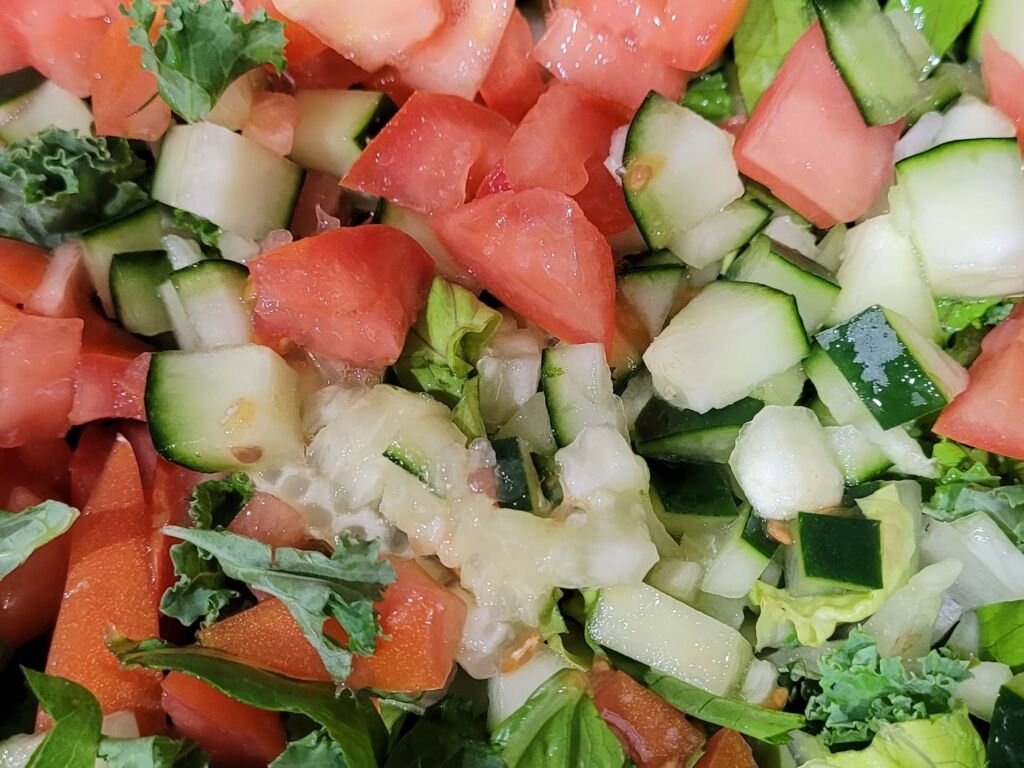
- Protein supports the production of immune cells and antibodies. A diet too low in protein can delay feather growth and weaken disease resistance.
- Vitamin A keeps the skin, eyes, and mucous membranes strong, forming a protective barrier against bacteria and viruses.
- Vitamin E acts as a natural antioxidant, protecting immune cells from damage caused by free radicals.
- Vitamin C helps the body handle stress and inflammation. While ducks can produce their own vitamin C, extra amounts can be helpful during illness or heat stress.
- Selenium and zinc are trace minerals that enhance immune cell activity and antibody production.
- Omega 3 and Omega 6 fatty acids support inflammation control and overall cell health.
Offering high-quality feed specifically formulated for ducks ensures they receive these nutrients in the right balance. I have had excellent experiences with Grubbly Farms Fresh Pecks, Mazuri Waterfowl Maintenance, and Purina Duck Feed Pellets. Since my flock can be picky, I rotate these feeds to keep them interested and maintain variety in their diet. Adding safe fresh greens and protein-rich treats, such as dried black soldier fly grubs, can also support a healthy immune response.
➡️ Learn more about nutritional needs for ducks and how different commercial duck feed compares
Clean Water
Water is more than a place for ducks to swim. It is an integral part of their hygiene and health. Ducks drink, clean their bills, and wash their eyes and nostrils in water, so it must always be clean and free of contaminants. Standing or dirty water quickly becomes a breeding ground for harmful bacteria, mold, and parasites.
I clean my ducks’ large pools about once a week and refill smaller bowls and buckets daily. Using shallow water dishes for drinking and feeding can help prevent contamination, since ducks love to dunk their food before swallowing.
➡️ Learn more about the importance of water for ducks.
Housing and Hygiene
The environment where ducks live directly influences their immune strength. Moist bedding, poor ventilation, and buildup of waste create conditions where bacteria and fungi thrive. Regular cleaning, combined with dry and absorbent bedding, reduces exposure to these pathogens.
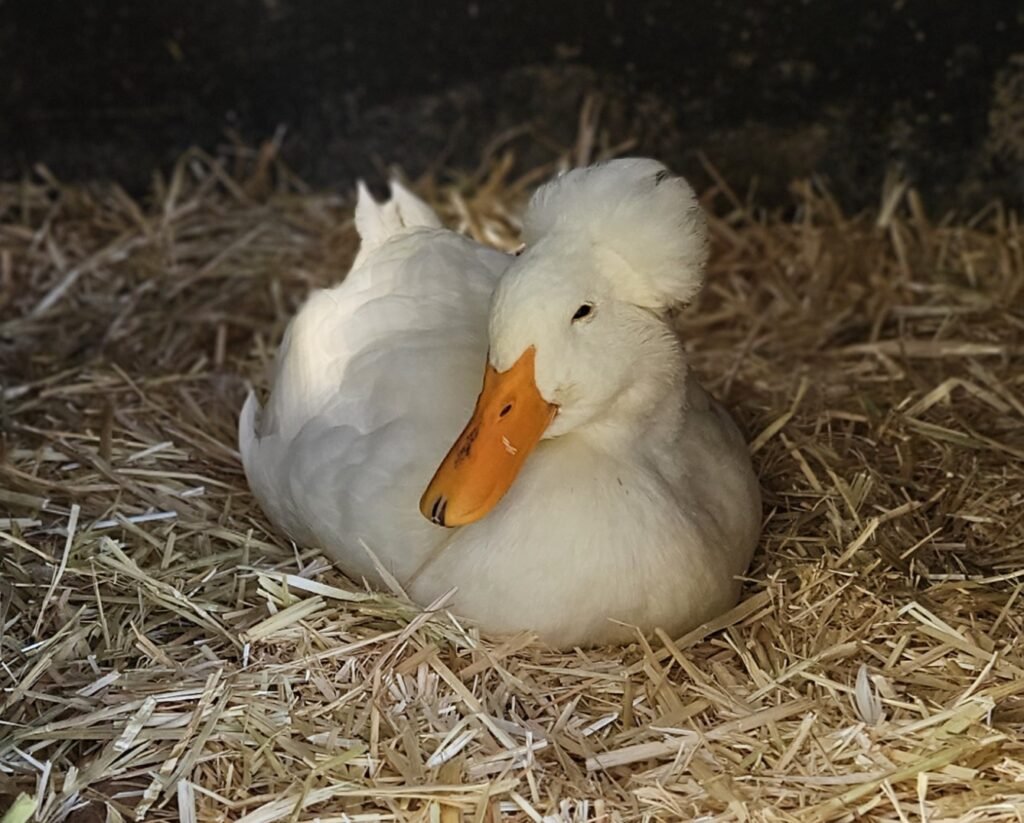
At Ducks of Providence, we use hemp bedding, straw, or pine shavings because they stay dry and reduce odors. The duck house should be well-ventilated but protected from drafts. Good airflow prevents ammonia buildup, which can irritate the respiratory tract and weaken immune defenses.
Outdoor runs should also stay clean and dry. When I switched from pea gravel to artificial turf, it significantly reduced foot injuries and bacterial growth while still providing excellent drainage.
Stress Reduction
Stress is one of the most overlooked factors affecting immunity. When a duck experiences stress, its body releases hormones that temporarily suppress immune function. Over time, this leaves the duck more vulnerable to infections.
Common sources of stress include:
- Overcrowding or lack of personal space
- Bullying among flock members
- Constant noise or predator threats
- Sudden weather changes or relocation
- Frequent handling or disruption of daily routine
To minimize stress, ensure your ducks have enough space to move freely, access to shaded resting spots, and a secure environment where they feel safe. Establishing a daily routine also helps ducks feel calm and stable.
Sunlight and Fresh Air
Sunlight supports the production of vitamin D, which helps regulate calcium absorption and immune function. Ducks benefit from daily outdoor time where they can stretch, bathe, and forage naturally. Fresh air reduces moisture and bacteria buildup in coops and shelters, which in turn lowers respiratory risks.
Even in colder months, allowing supervised outdoor time on dry, non-icy surfaces can do wonders for their health and mood.
Avoiding Toxins and Mold
Exposure to toxins or mold is a serious but often hidden threat to the immune system. Moldy feed can cause fungal infections such as aspergillosis, which damages the lungs and is difficult to treat. Always store feed in airtight containers and inspect it regularly for clumping, discoloration, or a musty smell.
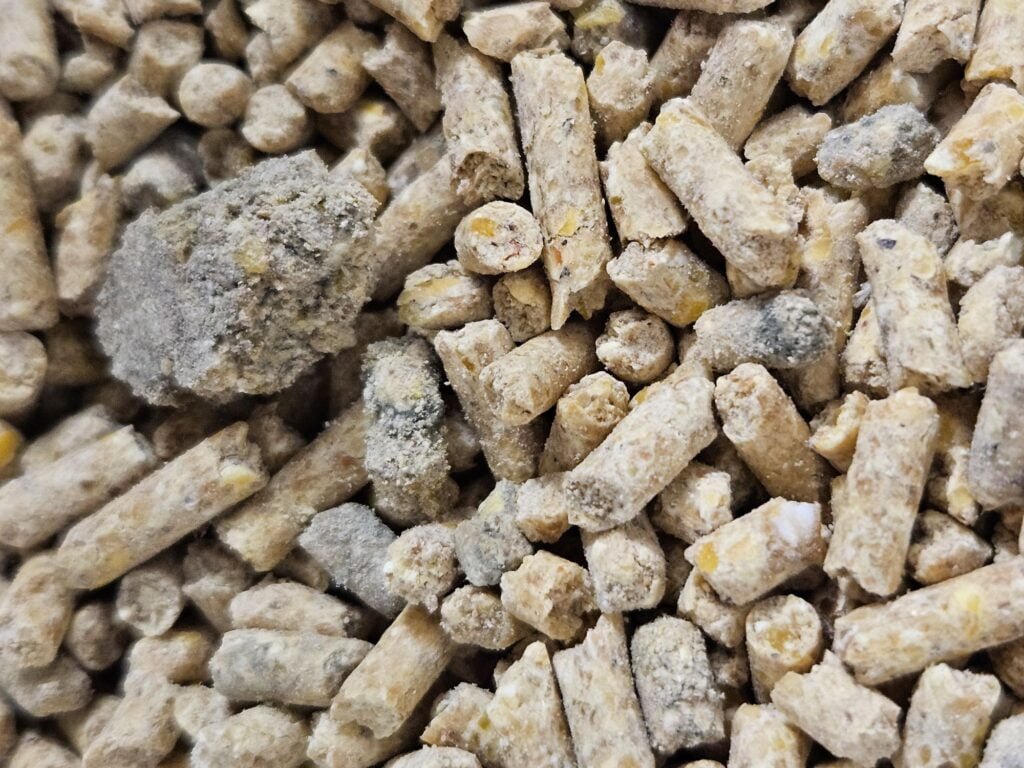
Avoid using pesticides, fertilizers, or chemical cleaners near the duck area, as ducks may ingest residues through foraging or preening. Even small amounts of metal objects like coins, screws, or wire can lead to zinc or lead poisoning, both of which severely weaken the immune system.
Age and Molting
The immune system changes with age. Ducklings rely heavily on antibodies passed through the yolk before hatching, which gives them early protection while their own immune organs develop. Older ducks may experience a gradual decline in immune strength, making them more prone to infections.
Molting, the process of replacing old feathers with new ones, also places extra demands on the body. During this time, the immune system may be temporarily less active as nutrients are redirected to feather growth. Offering extra protein and vitamins during molting helps maintain immune balance.
Social Stability
Ducks are social animals that thrive in stable flocks. A peaceful social structure reduces stress and supports immune health. When introducing new ducks, do so gradually, allowing both groups to see and hear each other before sharing space. Social harmony helps prevent bullying and keeps everyone calm and healthy.
Common Immune Challenges in Ducks
Even a healthy immune system can be tested at times. Ducks live close to the ground, often in damp areas, and spend a lot of time in shared water. All conditions that can expose them to germs and parasites. Most ducks handle mild exposure without problems, but certain situations can overwhelm their immune defenses. Recognizing these challenges early can help prevent serious illness.
Viral Infections
Viruses are among the most significant threats to ducks, and some can spread quickly through a flock.
Avian Influenza (Bird Flu):
Ducks are natural reservoirs for many strains of avian influenza. While some types cause little or no illness in ducks, others can lead to lethargy, respiratory distress, and sudden death. Wild waterfowl often carry these viruses and shed them in water, which is why good biosecurity and avoiding contact with wild birds are so important.

Duck Viral Enteritis (Duck Plague):
This herpesvirus affects both wild and domestic ducks and is often fatal. Symptoms include watery or bloody diarrhea, weakness, and sudden death. Vaccines are available in some regions for at-risk flocks.
Duck Hepatitis Virus:
This disease primarily affects young ducklings and can cause rapid death within hours. Maintaining good sanitation and separating age groups helps prevent outbreaks.
Bacterial Infections
Bacteria are everywhere in a duck’s environment, and most are harmless. However, under stress or poor living conditions, harmful bacteria can take over.
Salmonella and Escherichia coli (E. coli):
These bacteria are commonly found in contaminated feed or water. Infected ducks may show diarrhea, loss of appetite, or weakness. E. coli can also cause infections in the reproductive tract, leading to reduced egg laying or egg peritonitis.
Pasteurella multocida (Fowl Cholera):
This infection spreads quickly and may cause respiratory distress, swelling around the eyes, or sudden death. Good hygiene, rodent control, and vaccination (where available) are the best prevention strategies.
Staphylococcus and Bumblefoot:
This bacterial infection begins when bacteria enter through small cuts on the foot. Hard surfaces, such as gravel or rough concrete, increase the risk. Bumblefoot weakens the immune system further because the body must fight a constant localized infection. Using soft, dry flooring and keeping feet clean are key preventive steps.
Parasitic Infections
Parasites can strain a duck’s immune system, especially if the duck is under stress or not receiving proper nutrition.
Worms (Internal Parasites):
Roundworms, tapeworms, and gapeworms may live in the digestive or respiratory system. Signs include weight loss, poor feather quality, and lethargy. Routine fecal checks by a veterinarian and maintaining clean living areas help keep worms under control.
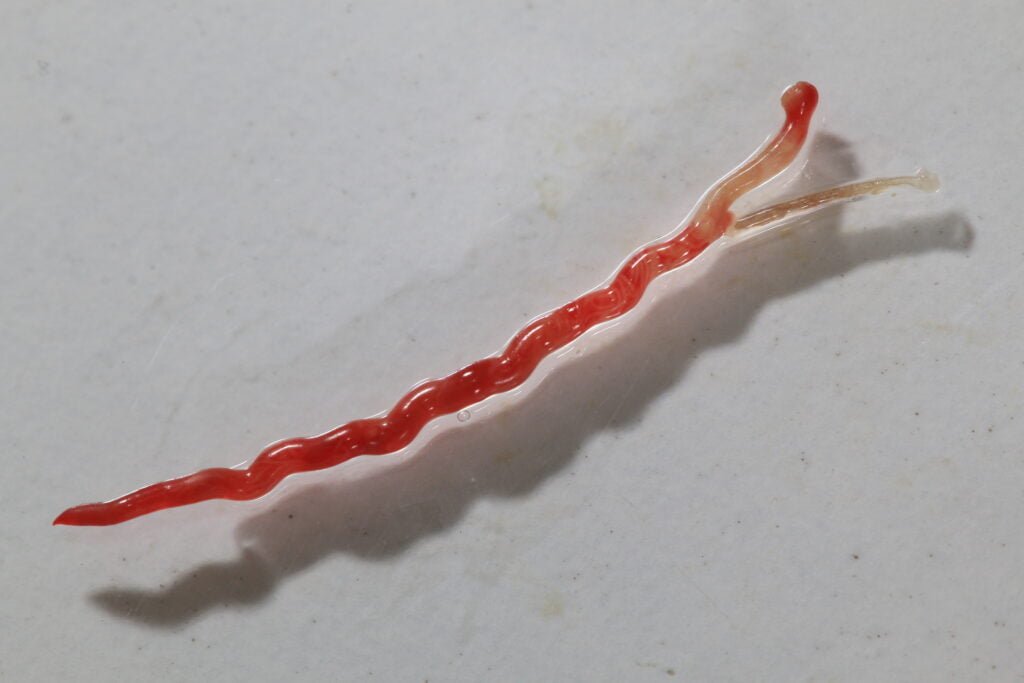
External Parasites:
Lice and mites irritate the skin, causing excessive preening, feather loss, or restlessness. Regular preening, swimming, and dust bathing help ducks control mild infestations naturally, but persistent cases require treatment and a full coop cleaning.
Fungal Infections
Fungal diseases, while less common, can be serious.
Aspergillosis:
This infection comes from inhaling mold spores, often from damp bedding or moldy feed. It affects the lungs and air sacs, causing labored breathing and reduced appetite. Prevention is far easier than treatment. Always keep bedding dry and feed fresh.
Nutritional and Environmental Stressors
A diet lacking key nutrients, exposure to toxins, or prolonged stress can weaken the immune system and make ducks more susceptible to infection. Moldy feed, dirty water, or contaminated soil can introduce multiple challenges at once. Even chronic overcrowding can suppress immunity by keeping stress levels high.
Reproductive and Hormonal Challenges
Laying hens experience natural immune fluctuations linked to hormone changes. During peak laying or when a duck is egg-bound, her body prioritizes reproductive function, which can temporarily reduce immune strength. Providing adequate calcium, vitamins, and rest periods supports overall balance.
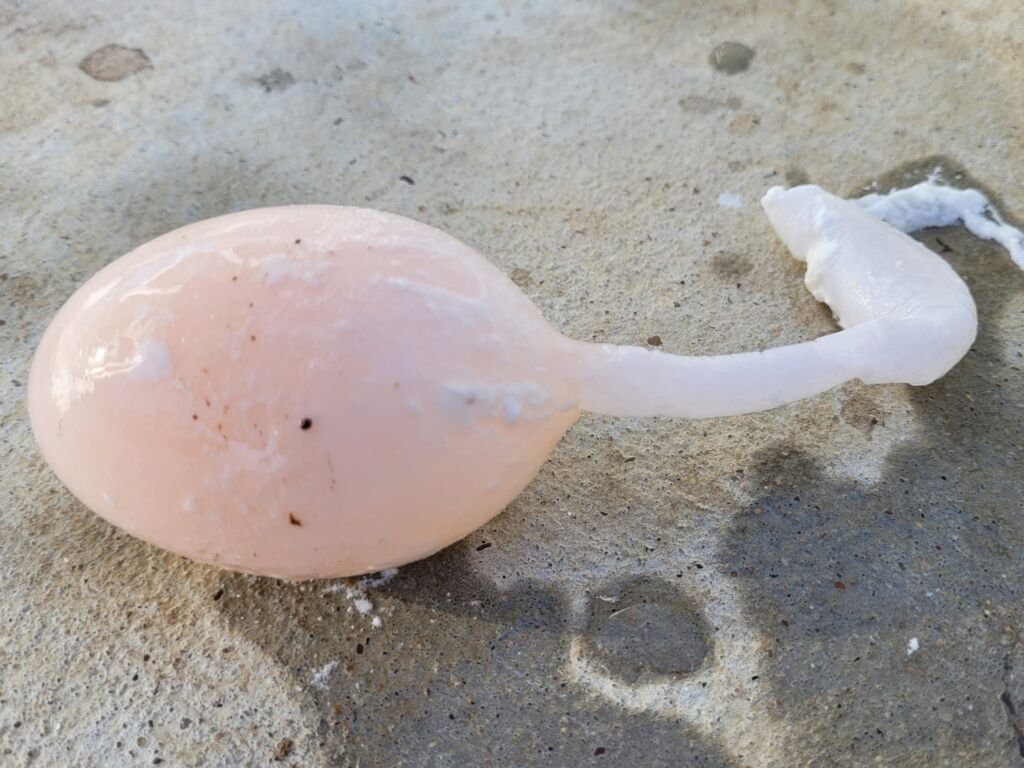
Human and Wildlife Transmission
Because ducks often share outdoor spaces with wild birds, disease transmission can occur through droppings or shared water sources. Limiting contact during outbreak seasons, using a covered run, and following flockdown recommendations during avian influenza alerts can dramatically reduce risk.
Supporting Your Duck’s Immune Health
Supporting your duck’s immune system starts with the basics: clean water, balanced nutrition, and a stress-free environment. But small additions to their daily routine can go a long way toward keeping them strong. With the right products and habits, you can help your ducks maintain peak health year-round.
1. Balanced Nutrition with Quality Feed
A high-quality feed is the foundation of immune support. Look for complete duck or waterfowl formulas that provide balanced protein and key nutrients such as vitamins A, E, and selenium. Feeds designed for chickens may not always provide enough niacin, which ducks need for proper leg and nerve health.
Recommended feeds:
- Mazuri Waterfowl Maintenance Diet – A trusted pelleted formula with balanced nutrition for adult ducks.
- Grubbly Farms All Flock – Made with black soldier fly grubs, rich in natural protein, calcium, and immune-boosting amino acids.
- Purina Duck Feed Pellets – A consistent choice for reliable nutrition and vitamin balance.
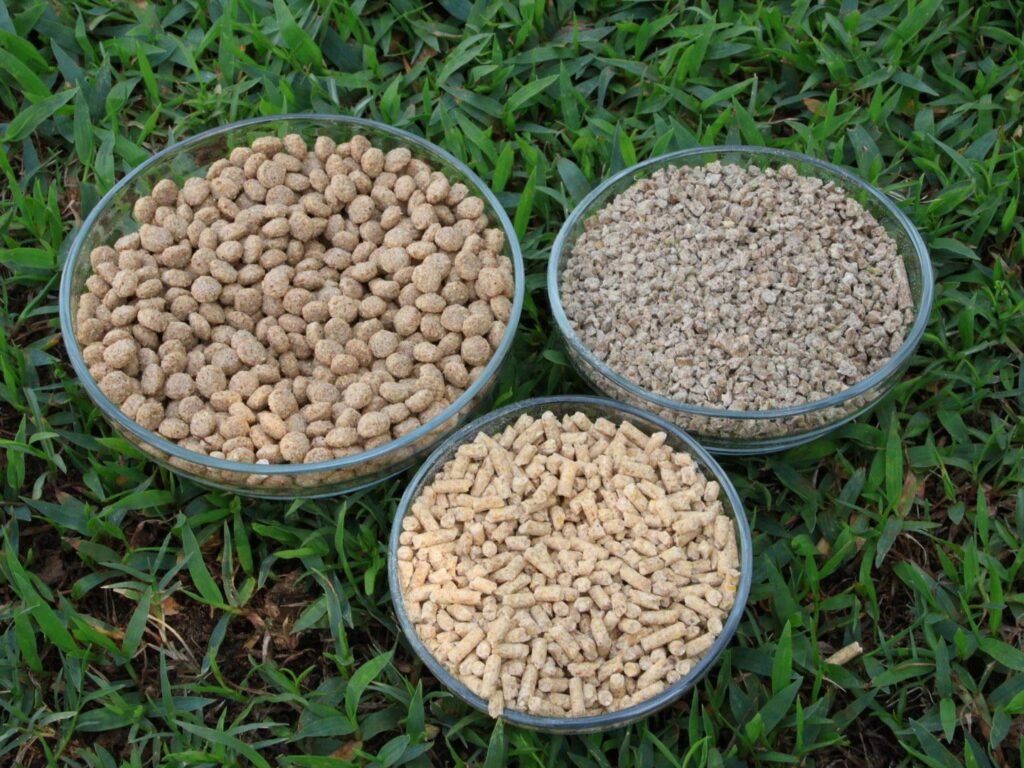
Rotating between brands can help meet nutritional diversity and keep picky eaters interested. Ducks that receive consistent, nutrient-dense feed show better feather condition, faster recovery from stress, and stronger resistance to disease.
2. Add Natural Supplements for Extra Support
Supplements can be especially helpful during molting, breeding, or illness recovery. These products help fill nutritional gaps and boost the immune system naturally.
Affiliate-friendly additions:
- Brewer’s Yeast with Garlic – Adds B vitamins and natural immune support; great for feather growth and stress resistance.
- Apple Cider Vinegar – A natural probiotic that supports digestion and overall immunity when added to clean drinking water.
- Electrolytes and Vitamins Powder – Ideal for hot days or stressful events such as travel or flock introductions. We like Hydro-Hen, Grubbly Farms Vitamins + Electrolytes, and Vitametz.
- Probiotic Poultry Supplement – Keeps the digestive system balanced and supports immune strength from the gut.
Introduce new supplements gradually and always follow dosage instructions. Over-supplementation can upset nutritional balance.
3. Keep Water Sources Clean and Safe
Ducks rely on water for nearly everything, from bathing to eating. Dirty or stagnant water can quickly harbor bacteria, so keeping it clean is one of the simplest yet most effective immune supports.
Helpful tools:
- Large Drainable Pet Pool – Easier to empty and clean than standard kiddie pools.
- Outdoor Water Hose Filter – Reduces chlorine and heavy metals from tap water.
At Ducks of Providence, we clean our main pool weekly and change smaller water bowls daily. Adding pavers or ramps helps ducks climb in and out safely and keeps mud under control.
4. Keep Their Environment Dry and Clean
A clean coop and run help prevent bacterial growth and respiratory problems that can weaken the immune system. Moist bedding, ammonia buildup, and poor airflow are common triggers for illness.
Recommended products:
- Hemp Bedding for Poultry – Naturally absorbent, low in dust, and compostable.
- Stainless Steel Feed and Water Bowls – Easy to sanitize and long-lasting.
- Pet-Safe Coop Cleaner – Use non-toxic formulas that are safe around ducks.
Inspect bedding regularly, replace soiled areas daily, and do a full clean-out every few weeks.
5. Support the Immune System Through Enrichment
Physical activity and mental stimulation reduce stress hormones that can suppress immunity. Ducks need room to forage, swim, and socialize. You can encourage natural behaviors with simple enrichment ideas:
- Add floating lettuce leaves or peas to their pool for foraging fun.
- Provide new textures, such as grass mats or turf patches, for exploration.
- Offer Foraging Toys for Poultry filled with small treats or dried grubs.
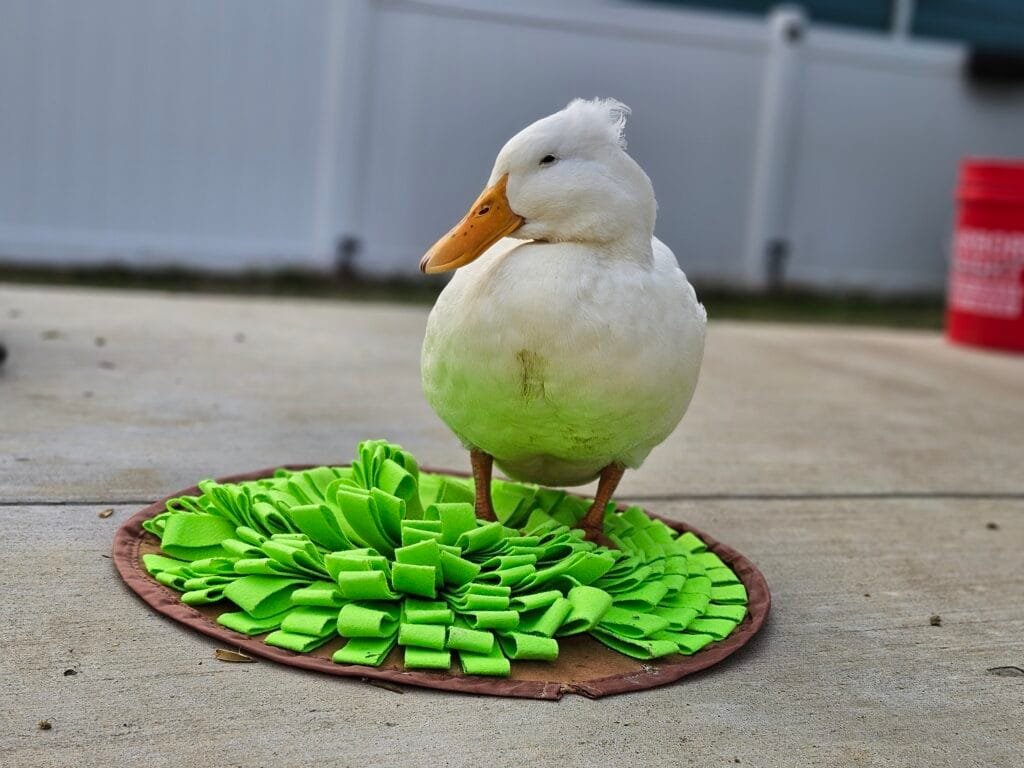
6. Provide Shade, Shelter, and Fresh Air
Sunlight boosts vitamin D production, which helps regulate the immune system. Fresh air also keeps respiratory passages healthy. A covered run or shaded shelter protects from predators, wild bird droppings, and overheating while still allowing airflow.
7. Regular Health Checks
Observation is one of the most valuable tools in duck keeping. Performing quick daily checks for changes in behavior, appetite, or feather quality helps catch problems before they escalate. Keep a simple Duck First Aid Kit on hand that includes saline rinse, wound spray, and antibiotic ointment safe for birds.
Scientific Insights: Why Ducks Resist Some Diseases Better
Ducks are known for their remarkable resilience, often staying healthy in conditions that would make other birds sick. This strength comes from unique biological adaptations that make the duck immune system distinct from that of chickens and many other species. Understanding these differences not only deepens our appreciation for ducks but also helps explain why certain diseases affect them differently.
The Role of the RIG I Gene
One of the key reasons ducks handle viral infections so effectively is a gene called RIG I (retinoic acid-inducible gene I). This gene enables duck cells to recognize viral RNA early during infection and trigger strong antiviral defenses. Chickens, in contrast, lack this gene entirely, which makes them more vulnerable to certain viruses, including avian influenza.
When a virus enters a duck’s body, RIG I acts as a sensor that detects abnormal genetic material. Once activated, it signals immune cells to produce antiviral molecules known as interferons, which block the virus from replicating. This early response gives ducks an important advantage, allowing them to control infections before they cause severe illness.
Adaptations to Wet Environments
Ducks live in constant contact with water, where bacteria and parasites thrive. Over time, their immune systems evolved to handle this exposure. Ducks produce antimicrobial peptides in their skin, mucus, and digestive tract that kill or neutralize harmful microbes. Their preen oil also contains compounds with antibacterial properties, helping protect the skin and feathers from infection.
Because of these natural defenses, ducks can safely spend long hours in ponds or muddy areas without frequent illness. Still, poor water quality or overcrowding can overwhelm these protections, which is why clean, managed environments remain essential.
Higher Body Temperature and Faster Metabolism
Ducks maintain a body temperature of about 107 degrees Fahrenheit, slightly higher than chickens and many mammals. This elevated temperature makes it harder for some bacteria and viruses to survive or multiply. Their faster metabolism also supports quick healing and efficient immune responses when facing infections or wounds.
Immune Memory and Longevity
Ducks develop strong immune memory after exposure to common environmental microbes. This means that once a duck has fought off a particular infection, it is often protected from that pathogen for life. Mature ducks that have grown up in stable, clean conditions tend to develop more balanced immune systems and fewer health issues than newly introduced or stressed individuals.
Comparing Ducks and Chickens
The differences between ducks and chickens go beyond behavior and habitat. They extend deep into their immune systems. Studies show that ducks mount more rapid and targeted antiviral responses, largely thanks to their RIG I gene and more active production of interferons. While chickens often develop severe symptoms from avian influenza, ducks may carry the virus without showing signs of illness.
This ability to tolerate and control certain infections does not mean ducks are invincible. They can still fall ill from bacterial infections, parasites, and stress-related diseases if their environment is poor or nutrition is lacking. But overall, their biology gives them a naturally strong foundation for health and survival.
Duck vs Chicken Immune System: Key Differences
| Feature | Duck Immune System | Chicken Immune System |
|---|---|---|
| RIG I Gene | Present. Detects viral RNA and triggers strong antiviral responses, including interferon production. This gene gives ducks higher resistance to many viral infections, including avian influenza. | Absent. Chickens rely on other sensors that are less effective, making them more susceptible to viruses such as avian influenza. |
| Interferon Beta (IFN β) | Produced rapidly after infection. Stimulates hundreds of antiviral genes and limits virus replication. | Produced at a slower rate and in lower amounts, allowing viruses to spread more easily. |
| Response to Avian Influenza | Often mild or asymptomatic. Ducks can carry and clear certain strains without severe illness. | Often severe or fatal, especially with highly pathogenic strains. |
| Antibody Types | Produces IgM, IgA, and IgY (avian equivalent of IgG). IgA is crucial for mucosal immunity and develops later in young ducks. | Produces similar antibody types, but with lower mucosal IgA activity compared to ducks. |
| Innate Immune Strength | Very strong. Rapid activation of antiviral genes and efficient phagocytic cells. | Weaker innate response. Slower activation of antiviral pathways. |
| Body Temperature | Around 107°F (41.6°C). The higher temperature helps limit bacterial growth. | Around 105°F (40.5°C). Slightly lower, which allows some pathogens to replicate more easily. |
| Preen Oil Function | Contains antimicrobial compounds that protect feathers and skin from microbes and fungi. | Also used for waterproofing, but with less antimicrobial activity than in ducks. |
| Environmental Adaptation | Evolved for constant contact with water, which shaped strong mucosal and skin defenses. | Terrestrial lifestyle led to stronger dry-environment defenses but weaker mucosal barriers. |
| Gastrointestinal Immunity | Robust gut-associated lymphoid tissue (GALT) for controlling bacteria from water and food. | Less developed GALT compared to ducks, making gut immunity slightly weaker. |
| Overall Disease Resistance | Generally higher. Ducks tolerate and recover from many infections more effectively. | More vulnerable to viral and respiratory diseases, requiring stricter management. |
Fun Facts About the Duck Immune System
The duck immune system is full of fascinating details that reveal just how well adapted these birds are to their watery world. Some of these traits might even surprise long-time duck keepers.
- Ducks receive early immunity from their mothers.
Before hatching, ducklings absorb antibodies directly from the yolk. These antibodies protect them during their first days of life until their own immune organs, such as the bursa of Fabricius and thymus, become active. - Their preen oil helps fight germs.
The oil ducks spread over their feathers is not just for waterproofing. It also contains natural antimicrobial compounds that keep bacteria and fungi from growing on the feathers and skin. - They stay healthier because of their high body temperature.
Ducks maintain an average body temperature around 107 degrees Fahrenheit. This higher temperature makes it difficult for many bacteria to survive or multiply, giving ducks a built-in layer of defense. - Bathing supports immunity.
Splashing and preening are not just fun activities. They help ducks clean away parasites and debris that could otherwise irritate the skin or harbor infections. Access to clean water is therefore essential for immune health. - Their immune organs shrink with age.
In young ducks, the thymus and bursa of Fabricius are large and active. As ducks mature, these organs shrink, which is why young birds often recover faster from illness than older ones. - Ducks have immune traits that chickens do not.
Ducks possess the RIG I gene, which allows them to detect and fight certain viruses early in infection. Chickens lack this gene, making ducks naturally more resistant to diseases like avian influenza. - A duck’s gut is its immune powerhouse.
The digestive tract contains millions of beneficial bacteria that train the immune system and keep harmful microbes under control. Probiotic supplements can help maintain this balance, especially during times of stress or antibiotic use. - Feather molting affects immunity.
During molting, ducks redirect energy and nutrients toward feather growth, which can temporarily weaken immune defenses. Extra protein and vitamins during this time support both feather renewal and immunity. - Healthy ducks rarely need medication.
A well-fed, low-stress duck with clean water and proper housing has an incredibly effective immune system. Prevention and good management are far more powerful than treatment after illness strikes.
Final Thoughts
The duck immune system is a remarkable example of nature’s design. Strong, adaptable, and beautifully balanced. From their specialized immune organs to their natural defenses like preen oil and antibodies, ducks are built to thrive in environments that many other animals could not handle. Still, even the strongest immune system needs support.
As duck keepers, we play a crucial role in helping these defenses function at their best. Clean water, quality feed, and a calm environment are not luxuries. They are the foundation of health. Small details, such as regular pool cleaning, providing shade, and ensuring access to nutritious treats, can make a world of difference.
When you understand how your duck’s body fights off illness, you can recognize subtle signs of imbalance early and take steps to prevent disease before it takes hold. Prevention through good care is always the best medicine.
Healthy ducks are happy ducks, energetic, curious, and full of personality. By supporting their immune systems naturally, we give them the best chance to live long, vibrant lives filled with splashes, quacks, and the gentle rhythm of daily duck life.

Related Articles
- Essential Nutritional Needs of Ducks: A Complete Overview
- Supplements for Ducks: What Your Pet Ducks Really Need
- Feeding Ducks: A Guide to Keeping Your Flock Happy and Healthy
- Creating the Perfect Home for Your Pet Ducks: Housing, Space, and Safety Tips
- 16 Common Duck Health Conditions You Should Know About
References
- Fleming-Canepa, Ximena et al. “Duck innate immune responses to high and low pathogenicity H5 avian influenza viruses.” Veterinary microbiology vol. 228 (2019): 101-111. doi:10.1016/j.vetmic.2018.11.018
- Boyu Zhai et al. “The Variation of Duck RIG-I-Mediated Innate Immune Response Induced by Different Virulence Avian Influenza Viruses” Frontiers in Microbiology, Volume 13 – 2022 | https://doi.org/10.3389/fmicb.2022.842721
- Mehrzad, J.; Shojaei, S.; Keivan, F.; Forouzanpour, D.; Sepahvand, H.; Kordi, A.; Hooshmand, P. Avian Innate and Adaptive Immune Components: A Comprehensive Review. J Poult Sci Avian Dis 2024, 2 (3), 73-96. https://doi.org/10.61838/kman.jpsad.2.3.7.
- Abdel-Fattah, Z., A. M. El-Bakry, A. S. A. Abuelsaad, et al. 2025. “ Age-Related Involutory Changes in Bursa of Fabricius of Anas crecca: Histomorphometric and Ultrastructural Investigation.” Veterinary Medicine and Science 11, no. 5: 11, e70555. https://doi.org/10.1002/vms3.70555


